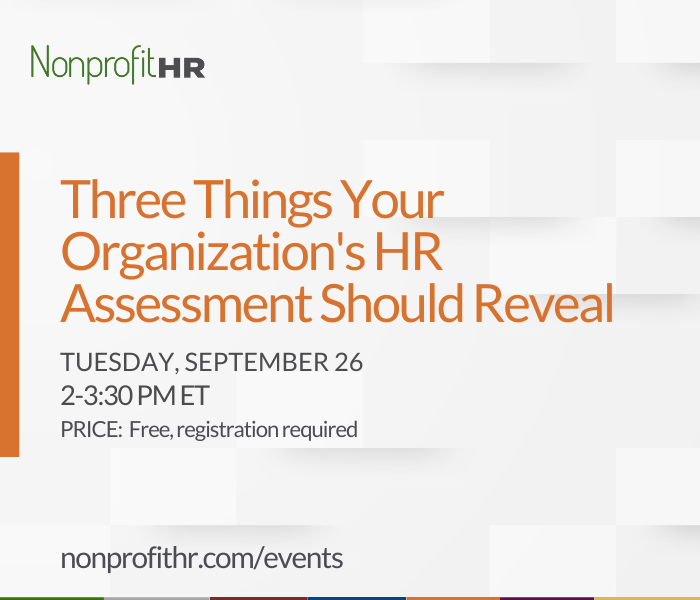WTOP: 5 ways nonprofits can…
Talent plays a critical role in nonprofit performance, but according to our 2016 Nonprofit Employment Practices Survey, 84 percent of nonprofits don’t have a formal retention strategy in place, and nonprofit employee turnover has gradually increased over the past few years. These data point to an ineffective approach to talent across the sector, and often, budgets are to blame.
Less than 1% of nonprofit funding has historically gone to supporting talent, and a mere .03% of the social sector’s annual spending has historically been allocated to leadership development. Those numbers are in danger of shrinking even further in the year ahead as nonprofits react to our new political climate and brace for both funding cuts and an increased demand for their programs and services, which could make many organizations’ budgets even tighter than usual.
You’ll create more problems than you solve if you cut your investment in talent to make room in an already stretched operating budget. Without an effective, engaged team to shepherd your mission, your other investments have little impact. If you hope to achieve true sustainability for your organization even in this time of uncertainty and budgetary struggle, you must continue to pay your talent competitively and commit both time and resources to strengthening your culture and HR function.
Fortunately, there are many ways to foster a healthy and effective workforce that do not require a direct financial outlay. Compensation is not the most important driver of employee satisfaction, and other factors like culture and values, organizational leadership, work life balance and career opportunities rank just as high. Here are several cost-effective, and often free, solutions for addressing those factors in order to keep investing in your talent no matter your budgetary constraints.
Define and prioritize your culture
No matter your nonprofit’s budget, you can have a strong organizational culture. And in fact, if you hope to advance your mission, you must.
According to James L. Heskett, culture “can account for 20-30% of the differential in performance when compared to ‘culturally unremarkable’ competitors.” Put simply, the most effective nonprofits are often those where employees have the highest level of culture satisfaction.
If you’re ready to truly prioritize your organization’s culture, first involve your entire team in the process of defining it. Harvard Business Review suggests six components of an effective corporate culture, which we believe apply to nonprofits as well. They include:
- Vision
- Values
- Practices
- People
- Narrative
- Place
Have discussions with various constituencies from within your organization to discuss how they view each of these elements today, and how they hope to see them evolve in the future. In the process, you may identify a need to bring in a consultant or earmark time for strategic planning to more deeply define one or more elements of your culture that is currently vague.
If you’re unclear where your organization stands from a culture perspective, consider conducting a cultural needs assessment to better understand your current employee and cultural dynamics. The findings should help you chart a roadmap for continuously improving your organization’s culture in the months and years ahead.
As you pursue cultural improvement initiatives based on findings from a needs assessment, make sure that the values your organization has chosen to champion are demonstrated from the leadership team down. To foster a strong culture, the values you espouse externally must be mirrored internally, and that begins with your leaders.
One example of a nonprofit with a strong organizational culture is SoundExchange, an independent nonprofit collective management organization that collects and distributes digital performance royalties to featured artists and copyright holders. The SoundExchange team––budding musicians, music aficionados, technology and data buffs ––is bound by a shared passion for the mission and clear culture.
Get serious about diversity initiatives
According to a recent Glassdoor survey, 67 percent of passive jobseekers indicated that a diverse workforce is an important factor when considering employers and offers. But diversity impacts far more than just recruiting. It also plays a significant role in organizational performance. McKinsey recently found that diverse companies are 35 percent more likely to outperform less diverse companies.
It’s especially critical for nonprofit organizations to mirror the communities and populations they serve, and as The Chronicle of Philanthropy explored in their March issue, the recent professionalization of nonprofit leadership has made this increasingly challenging in recent years.
The conversation at our 2017 Nonprofit Talent & Culture Summit came back to diversity, equity & inclusion again and again, and most sector leaders agreed that an effective DEI approach requires far more than creating an environment where all employees are welcomed. Today, to reap the benefits that come from fostering a diverse, inclusive organization, nonprofits must recognize that diversity involves more than gender, race and and orientation, and acknowledge anything — visible and invisible — a team member can bring to the table. Economic and educational diversity are just two examples, but harder to discern factors like learning style and interpersonal relationship styles should also factor into the diversity equation.
Fortunately, your organization can improve its approach to diversity hiring any time, no matter how tight your budget may be. Here are a few ideas for few simple changes you can make today:
- Forgo requirements for college degrees on some of your open positions and recognize that alternative education like tech school or on-the-job training may prepare employees well for certain roles
- Incorporate psychometric assessments into your hiring process in order to screen for diversity of thought
- Screen your job postings for language that may appeal to a certain group while turning away another. For example, a small nonprofit recently realized that by explaining some of their cultural offerings in their job descriptions (craft beer tasting parties and golf outings) they were appealing primarily to white male applicants while alienating other groups.
- Experiment with blind recruitment
Incorporate new management and feedback processes
Accenture recently reported that 89 percent of employees believe that their job performance could improve with better workplace feedback processes, and many organizations are taking notice. Companies like Google and nonprofits like Feeding America have made moves to revamp their performance management systems and practices in recent months.
And while completely overhauling your approach to performance management can be costly and time consuming, especially for large organizations, you can make incremental improvements now, even with a tight budget, and see major results. Consider small shifts like:
- Moving from long, onerous annual reviews to shorter, quarterly reviews
- Implementing a tool like Fizz or Wirl to give managers and employees a forum for providing continuous, two-way feedback between performance reviews
- Evaluating your current performance management tools to find out if they’re user-friendly and simplifying elements that are not
With more active, continuous feedback, your team members will feel more engaged and satisfied even if your budget for more major talent investments is limited.
Encourage self-care and work life balance
According to a recent webcast given by the Society for Human Resource Management (SHRM), 78% of employees who are in good health are also happy with their jobs. Actively promote self-care and let your team know that even in times of budgetary challenge, you value their well-being as much as your organization’s.
Educate your team members regularly on how they can incorporate better wellness practices into their daily routines. Hold lunch or breakfast events where your team can come together and discuss topics surrounding healthy living or nominate one team member each month to talk about a new healthy practice they’ve incorporated into their own days.
And when you’re ready to make your commitment to wellness more actionable, consider hosting in-office exercise classes, massages or even chiropractor visits. Many of our clients have partnered with local businesses like yoga studios and dance instructors who are willing to offer classes and sessions on a pro-bono basis to nonprofit employees.
While discussions and wellness offerings can let employees know how much you value them as whole people, the most important part of encouraging self-care and work-life balance is demonstrating a commitment to both at a leadership level. If your president or CEO works every evening and weekend and shows signs of burnout at the office, what’s to keep the rest of the team from doing the same? Championing self-care at a leadership level costs your organization nothing, but can have major benefits for your leaders and employees alike.
Two examples of nonprofits exhibiting exceptional wellness programs are the American Society of Hematology (ASH) and the American Speech Language Hearing Association (ASHA).
The bottom line
Don’t wait for your organization’s budgetary constraints to loosen to invest in your talent. Continue to compensate your team members competitively, give your human resources function the time and resources it needs to be successful, and begin implementing some of these accessible, low-cost strategies now to keep your employees engaged and effective. The causes and communities you serve have never needed your team more than they do now.





































